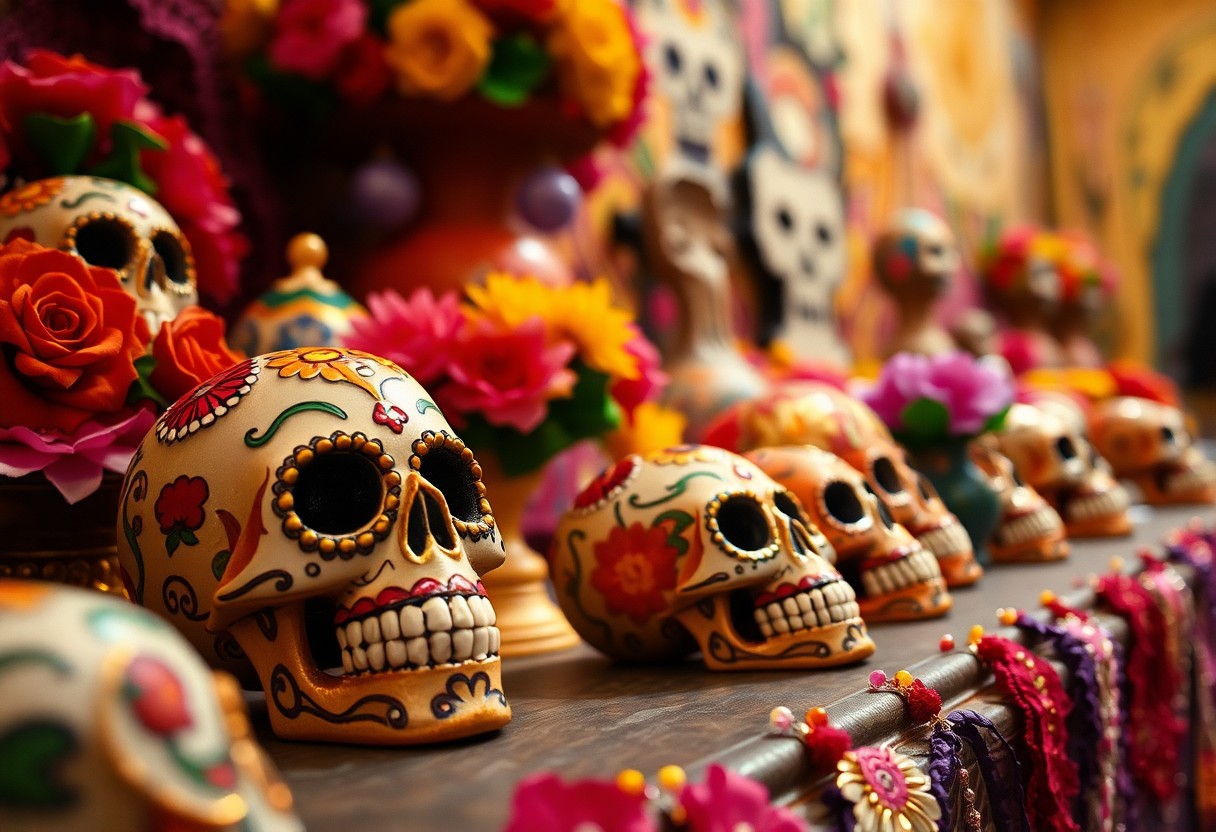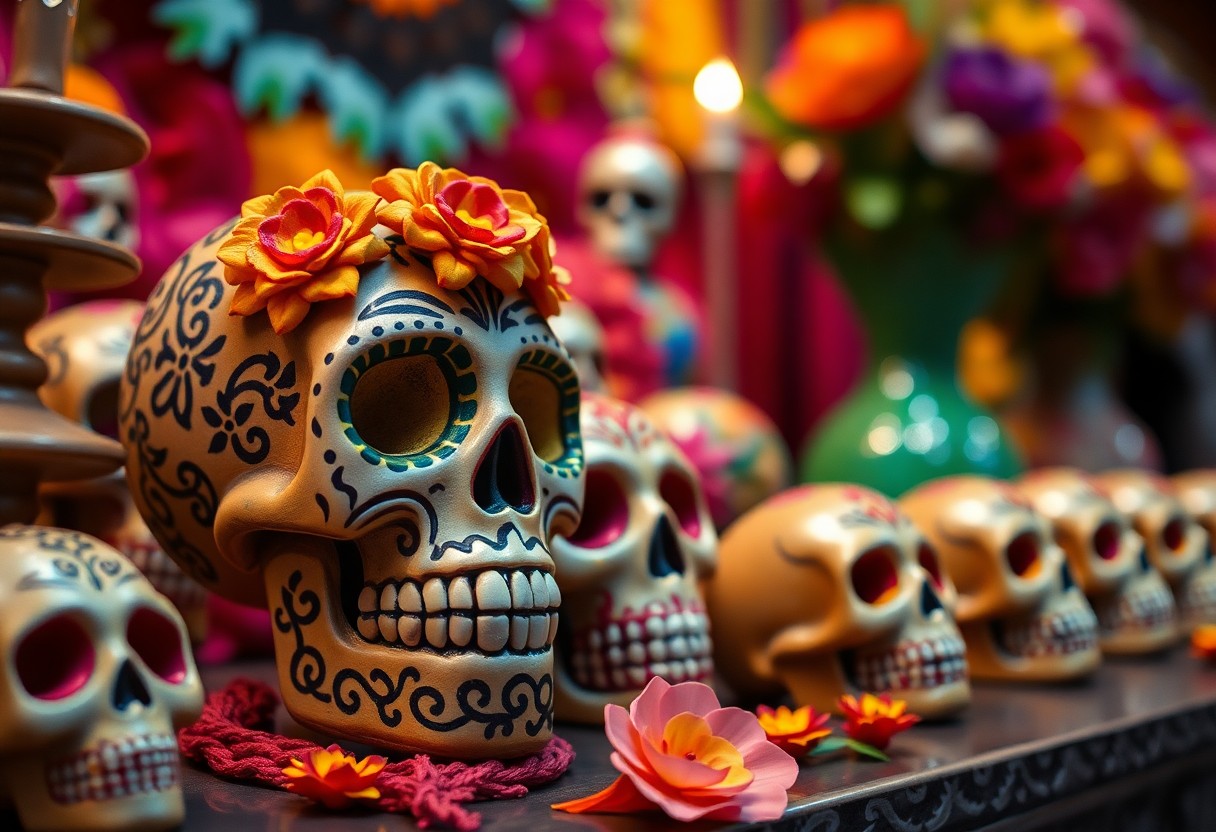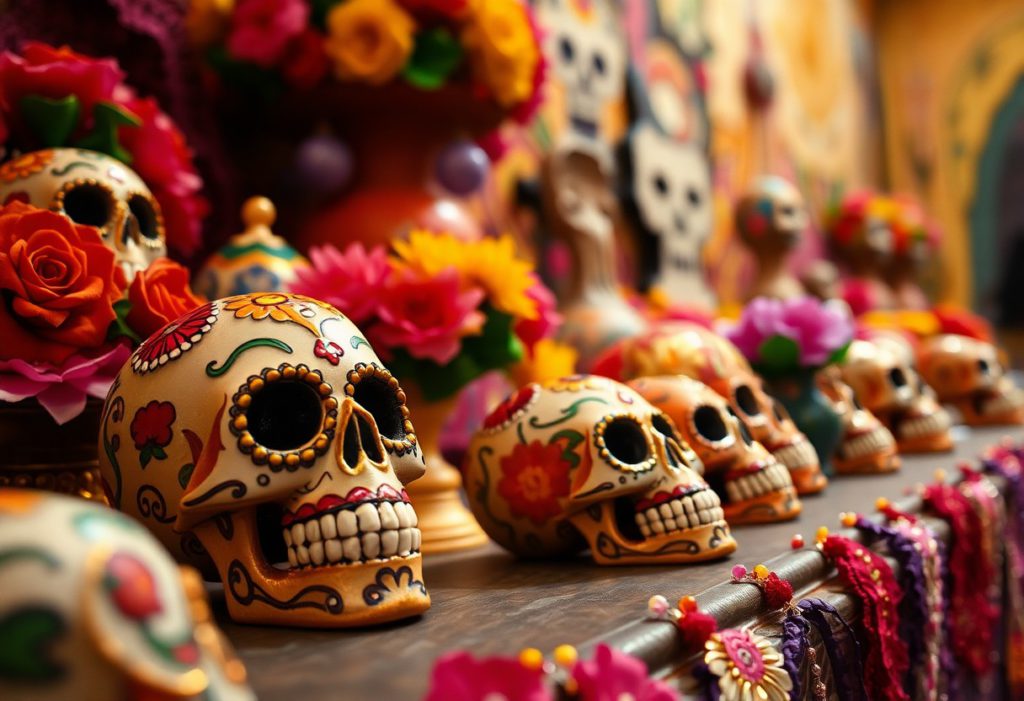Alfeñiques are beautifully crafted sugar figures that hold immense cultural significance during the vibrant celebrations of Día de Muertos, especially in the picturesque town of San Miguel de Allende. These colorful creations take the form of skulls, animals, and other culturally relevant shapes, serving as a heartfelt tribute to honor the memories of those who have passed away. Adorning ofrendas, or altars, during this deeply meaningful festival, alfeñiques represent a rich tapestry of traditions that have developed over centuries. They reflect a harmonious blend of Arabic, Spanish, and Mexican influences, resulting in a unique and cherished art form. The annual Alfeñique Fair in San Miguel de Allende is a vibrant celebration of this artistry, offering a splendid opportunity to witness skilled artisans at work while honoring the cultural depth of Día de Muertos. Explore how these sweet creations create a profound connection between life, death, and cultural heritage.
Discover the Rich Cultural Importance of Alfeñiques in Día de Muertos Celebrations
Your exploration of alfeñiques begins with a thorough understanding of their rich cultural importance. These sugar masterpieces are more than just delicate, handmade figures; they are often intricately shaped into skulls, animals, and other symbolic forms that resonate at the core of Día de Muertos festivities. Crafted to celebrate the essence of life while paying homage to the deceased, these artistic creations infuse vibrant colors and detailed craftsmanship into ofrendas across Mexico. The presence of alfeñiques brings joy and reverence to the celebrations, making them an essential and cherished component of a tradition that resonates profoundly with both the living and the spirits of departed loved ones. Through the art of alfeñiques, we are able to connect with treasured memories and the lasting legacy of those we have lost.
Unraveling the Deep Symbolism Embedded in Alfeñiques
Alfeñiques are not simply delightful confections; they serve as profound symbolic representations of the intricate themes surrounding life, death, and the connections that bind them. Each sugar figure is crafted with meticulous attention to detail, embodying the sweetness of existence alongside the cherished memories of loved ones who are no longer with us. The vibrant colors and intricate designs not only celebrate life but also act as heartfelt tributes placed upon altars, serving as poignant reminders of the enduring bonds that transcend death. Through their artistry, alfeñiques provide a deeper understanding of mortality and the perpetual cycle of life, enriching the experience of Día de Muertos and inviting reflection on the beauty of existence.
Explore the Traditional Shapes and Symbolic Colors of Alfeñiques
Alfeñiques come in an impressive array of traditional shapes, including skulls, crosses, animals, and flowers, each representing significant symbolic meanings. Skulls signify the eternal cycle of life and death, while animals often symbolize spiritual guides that accompany souls on their journeys. The colors used in these creations are equally important; bright hues such as red, yellow, and blue signify vitality and joy, while white embodies purity and remembrance. Each shape and hue of alfeñiques carries intentional layers of cultural significance, enhancing their role during Día de Muertos. Skulls, or calaveras, are particularly iconic and are often personalized with names or unique designs to honor specific individuals. This personalization transforms each piece into a unique tribute, deeply connecting families to their loved ones.
Animals such as dogs and deer are believed to serve as spiritual guides, while vibrant flowers symbolize the fleeting beauty of life. The rich palette of vibrant colors ensures these figures stand out on altars, creating a joyful and celebratory atmosphere during Día de Muertos festivities. This invites all participants to reflect not only on the beauty of life but also on the cherished memories of those who have departed.

Delve into the Historical Origins and Cultural Relevance of Alfeñiques
The term alfeñique has its roots in the Arabic word alfainid, suggesting a rich history that began during the Moorish period in Spain. This sweet art form was originally introduced to Spain, where it was crafted using almonds, sugar, and egg whites. With the arrival of Spanish colonizers in the Americas, this tradition journeyed with them, evolving into a distinctly Mexican form as local ingredients and unique cultural practices were integrated. Over the centuries, artisans have refined the sugar paste recipe, resulting in the vibrant and whimsical figures we associate with Día de Muertos today. These sugar masterpieces not only reflect Mexico's diverse cultural heritage but also showcase the remarkable ability to adapt and transform foreign influences into something uniquely Mexican.
Investigating the Arabic and Spanish Influences on Alfeñique Craftsmanship
The fascinating fusion of Arabic and Spanish influences is one of the most captivating aspects of alfeñiques. The technique for crafting sugar paste was introduced to Spain by the Moors, who skillfully utilized almonds and sugar to create exquisite sweets. As Spanish settlers arrived in the Americas, they carried this tradition with them, which was gradually adapted by Mexican artisans who replaced almonds with locally sourced ingredients. This transformation reflects the adaptability and creativity inherent in Mexican culture, merging diverse cultural influences into the enchanting art of alfeñiques, which continues to thrive and evolve today.
Tracing the Transformation of Alfeñiques in Mexican Cultural Context
To truly appreciate the evolution of alfeñiques within Mexican culture, one must explore how they have become intricately intertwined with the significance of Día de Muertos. Initially created as sweet treats, these sugar figures gradually adopted deeper symbolic meanings, representing the complex relationship between life, death, and remembrance. Today, artisans skillfully craft alfeñiques into various forms such as skulls, animals, and other figures, each vividly adorned with vibrant colors and intricate details. These creations serve not only as decorative pieces but also as profound means of honoring loved ones and celebrating the cyclical nature of life and death.
As Día de Muertos has grown in recognition as a national celebration, alfeñiques have emerged as a central element of ofrendas, significantly enhancing their significance. Artisans personalize these figures with names, dates, and heartfelt messages, infusing them with deeper meaning for families. In San Miguel de Allende, the annual Alfeñique Fair serves as a vibrant showcase for this evolution, blending traditional designs with contemporary creativity. This fair emphasizes the enduring significance of alfeñiques in Mexican culture, ensuring that this beautiful art form continues to flourish for generations to come.
Recognizing the Essential Role of Alfeñiques in Día de Muertos Ofrendas
Among the most cherished elements adorning a Día de Muertos ofrenda are the enchanting alfeñiques. These sugar figures encapsulate the sweetness of life while honoring the treasured memories of loved ones who have passed away. When placed on altars, they contribute vibrant colors and intricate details, creating a joyous atmosphere that celebrates both life and death. Alfeñiques often feature personalized designs, transforming them into heartfelt tributes for those being honored. In San Miguel de Allende, these sugar creations play a pivotal role in the tradition, reflecting the town's profound connection to Día de Muertos and its rich cultural heritage.
Understanding the Symbolism of Alfeñiques on Ofrendas
The symbolism of alfeñiques on ofrendas is deeply rooted in Mexican culture, where these sugar figures often take the shape of skulls, crosses, or animals, each embodying its own rich meaning. Skulls poignantly represent the life-death cycle, while crosses symbolize faith and protection in the afterlife. Animals such as butterflies or dogs signify the journey of the soul or loyalty to loved ones. The vibrant colors and intricate designs of alfeñiques infuse joy and celebration into the altar, serving as beautiful reminders of the interconnectedness of life and remembrance, creating a heartfelt tribute to those who have departed.
The Deep Personalization and Meaning Behind Alfeñiques
There is a deeply personal touch to alfeñiques that enhances their significance in a meaningful way. Artisans often inscribe names or heartfelt messages on the figures, dedicating them to specific loved ones, thus transforming the sugar art into a powerful tribute. In San Miguel de Allende, families take pride in selecting or crafting alfeñiques that reflect the personality or interests of their loved ones, ensuring that each piece is unique and heartfelt.
With alfeñiques, the personalization process transcends mere name inscriptions. Families may choose specific shapes, colors, or designs that hold special significance for their loved ones. For instance, a beloved animal or flower might be crafted into the figure, adding layers of meaning and connection. This attention to detail ensures that the ofrenda is not just a display but a powerful connection to the past. In San Miguel de Allende, this tradition is celebrated with great care as the community unites to honor their heritage and loved ones through these sweet, symbolic creations.
Experience the Vibrancy of the Alfeñique Fair in San Miguel de Allende
Many visitors to San Miguel de Allende find themselves captivated by the annual Alfeñique Fair, a vibrant celebration of sugar art during the Día de Muertos festivities. Held at Plaza de la Soledad, adjacent to the Oratorio Church, this fair transforms into a visual feast, showcasing the intricate craftsmanship of local artisans. Here, you can explore a diverse array of alfeñiques, ranging from traditional skulls and crosses to imaginative animal and floral designs. The fair embodies a lively blend of art, culture, and community, offering a unique opportunity to immerse yourself in the rich traditions of Día de Muertos in one of Mexico’s most picturesque towns.
Unmissable Highlights of the Alfeñique Fair
The Alfeñique Fair in San Miguel de Allende is a must-visit event during the Día de Muertos celebrations. You will discover rows of stalls brimming with colorful sugar figures, each crafted with precision and care, capturing the festival's vibrant spirit. This fair attracts both locals and tourists, creating a festive atmosphere that buzzes with excitement. Visitors can observe artisans demonstrating their techniques, learn about the rich history and significance of alfeñiques, and even try their hand at creating their own masterpieces. This fair provides the perfect opportunity to immerse yourself in the traditions of San Miguel de Allende while supporting local craftspeople and celebrating creativity.
Artisan Showcase and the Cultural Significance of Alfeñiques
A visit to the Alfeñique Fair reveals the deep cultural significance of these sugar creations, showcasing the artistry and dedication of the artisans involved. You’ll witness how artisans pour their creativity into each piece, blending traditional designs with modern interpretations that resonate with contemporary audiences. The fair highlights the crucial role of alfeñiques in Día de Muertos celebrations, where they symbolize both the sweetness of life and the cherished memories of loved ones. By purchasing these handmade figures, you actively contribute to the preservation of centuries-old traditions while honoring the artisans’ skill and commitment to their craft.
With over 50 local artisans participating annually, the fair stands as a testament to the enduring legacy of alfeñiques in San Miguel de Allende. Each piece reflects the region’s rich cultural heritage, from the vibrant colors to the intricate details. The fair also serves as a reminder of the importance of community in keeping these cherished traditions alive. By attending, you not only witness the artistry but also become part of a celebration that bridges the past and present, ensuring these customs are passed down to future generations.

Understanding the Varied Types of Alfeñiques and Their Unique Meanings
Not all alfeñiques are created equal; these sugar creations come in a variety of forms, each holding its unique meaning and purpose. Here are the most common types of alfeñiques that you might encounter:
- Skulls (calaveras): Representing deceased loved ones, often personalized with names to honor specific individuals and preserve their memories.
- Animals: Symbolizing spiritual guides or beloved pets of the departed, reflecting their connection to the afterlife and the bonds shared.
- Crosses: Reflecting faith and the connection between life and death, serving as spiritual reminders of the journey beyond.
- Fruits: Signifying abundance and the sweetness of life, celebrating the gifts of nature and the joys they bring.
- Angels: Representing protection and the spiritual realm, offering comfort to both the living and the departed.
Understanding the various types of alfeñiques enhances your appreciation of their role in the rich tapestry of Día de Muertos celebrations, highlighting the importance of each creation as a meaningful tribute to loved ones.
| Type | Symbolism |
|---|---|
| Skulls | Deceased loved ones |
| Animals | Spiritual guides or pets |
| Crosses | Faith and life-death connection |
| Fruits | Abundance and sweetness of life |
| Angels | Protection and spirituality |
Celebrating the Timeless Traditional Designs of Alfeñiques
Traditional alfeñiques focus on classic symbols like skulls, crosses, and animals. These designs are deeply rooted in Mexican culture, often showcasing vibrant colors and intricate details that captivate the observer. They reflect the delicate balance between life and death, which is a central theme of Día de Muertos. These timeless creations continue to be widely used in ofrendas, showcasing the enduring legacy of this cherished art form.
Embracing Creative Modern Interpretations of Alfeñiques
Modern alfeñiques have evolved to embrace contemporary themes and pop culture, showcasing the creativity of artisans. Figures now include superheroes, cartoon characters, and even celebrities, appealing to younger generations while keeping the tradition vibrant. You’ll find these innovative pieces at fairs like the one in San Miguel de Allende, where tradition and creativity beautifully intertwine.
For example, modern alfeñiques often feature vibrant colors and unconventional shapes, making them stand out on altars and attracting attention from all who see them. While some purists may view these changes as a departure from tradition, they serve to keep the art form relevant and engaging for new audiences. The Alfeñique Fair in San Miguel de Allende is an ideal venue for experiencing these modern designs, offering a glimpse into how this centuries-old craft continues to adapt and flourish within contemporary culture.
Your Comprehensive Guide to Crafting Alfeñiques: Tips and Techniques
To craft your own alfeñiques, you'll need a blend of patience, creativity, and the appropriate tools. Start by preparing your workspace, ensuring it is clean and has flat surfaces for your work. Utilize food-safe molds for creating consistent shapes, and use edible dyes to achieve the vibrant colors that are synonymous with these creations. Keep your sugar paste pliable by covering it with a damp cloth while you work. It’s advisable to work in small sections to prevent the paste from drying out too quickly. The key is to handle the sugar paste gently to avoid cracks. Finally, allow your creations to dry completely before displaying them on your ofrenda to honor your loved ones with your artistic expression.
Essential Ingredients and Tools for Crafting Authentic Alfeñiques
Crafting alfeñiques requires several essential ingredients and tools. You will need granulated sugar, egg whites, and lemon juice to create the sugar paste. For shaping your alfeñiques, you can utilize food-safe molds or sculpt the figures by hand. Additionally, edible dyes or food coloring are necessary to add the vibrant hues that make your creations visually appealing. A rolling pin, small brushes, and a damp cloth are also helpful for smoothing and detailing your designs. With these items, you can create beautiful, traditional alfeñiques that will enhance your Día de Muertos altar and honor your loved ones in a personal and artistic way.
Beginner Techniques for Successfully Crafting Alfeñiques
With your ingredients and tools ready, begin by kneading the sugar paste until it becomes smooth and pliable. Roll it out evenly and press it into molds or shape it by hand according to your preferred designs. Use small brushes to add details with edible dyes, working quickly to prevent the paste from drying out. If any cracks appear, smooth them over with a damp cloth or your fingers. The key to mastering alfeñique crafting lies in precision and patience, so be sure to take your time and enjoy the creative process.
To excel in alfeñique crafting, focus on precision and patience. Avoid overworking the sugar paste, as it can dry out and crack easily. It’s essential to maintain a clean workspace to prevent contamination. Always utilize food-safe materials to ensure your creations are safe to display and handle. One of the most crucial steps is to allow your alfeñiques to dry completely before moving them, as they remain fragile while wet. With practice and dedication, you’ll create stunning sugar art that honors the rich tradition of Día de Muertos in the beautiful context of San Miguel de Allende.
Your Step-by-Step Guide to Crafting Stunning Alfeñiques
After gathering all your ingredients and tools, follow this simple guide to create your very own alfeñiques. The process involves preparing the sugar paste, shaping it into your desired forms, and decorating with vibrant colors. Below is a breakdown of the steps involved:
| 1. Prepare the Sugar Paste | Mix sugar, water, and lemon juice until smooth and pliable. |
| 2. Shape the Figures | Mold the paste into skulls, animals, or other symbolic shapes that resonate with you and your loved ones. |
| 3. Dry the Figures | Allow the shapes to air-dry for several hours until they become firm and sturdy. |
| 4. Decorate | Use food coloring, icing, and edible glitter to add intricate details and vibrant finishes to your creations. |
Preparing the Sugar Paste for Crafting Alfeñiques
Begin the process by combining sugar, water, and lemon juice in a pot over medium heat. Stir continuously until the mixture reaches a thick, smooth consistency, ensuring not to let the sugar burn. Be cautious as sugar can easily reach high temperatures. Once ready, allow it to cool slightly before kneading it into a pliable dough. This paste serves as the foundation for your alfeñiques, so it’s essential to ensure it’s smooth and free of lumps to achieve the best artistic results.
Shaping and Decorating Your Unique Alfeñiques
The shaping of the figures is where your creativity truly shines. Roll the sugar paste into small balls or logs, and then expertly shape them into skulls, animals, or flowers using molds or your hands for precision. Once you have shaped your figures, allow them to dry completely before adding color. Patience is key during this stage to avoid any smudging of the intricate designs you’ve created.
As you decorate your sugar figures, remember they are delicate, so handle them with care. Use food-safe brushes to apply vibrant colors and edible glitter, enhancing their visual appeal. Bright hues like red, yellow, and blue are traditional for Día de Muertos, but feel free to personalize your designs with your own creative flair. Allow the decorations to set fully before proudly displaying your alfeñiques on your Día de Muertos altar, where they will beautifully honor the memories of your loved ones.
Key Factors Influencing the Artistry and Craftsmanship of Alfeñiques
For alfeñique artistry to truly thrive, several essential factors play a crucial role. The skill of the artisan, the quality of ingredients, and the cultural significance</a
Comments are closed


The artistry of alfeñiques beautifully encapsulates the spirit of Día de Muertos, and it’s fascinating how these sugar figures weave together such a rich cultural narrative. It’s not just about the visual appeal; the symbolism behind each creation carries stories of love, loss, and remembrance that resonate deeply within families and communities. During my visit to San Miguel de Allende last year, I was captivated by how artisans not only crafted these figures but also shared their personal connections to the traditions.
Your reflections really resonate with the heart of what Día de Muertos represents. The way alfeñiques encapsulate emotions is truly remarkable. Each figure is more than just sugar and color; it’s an expression of personal stories that honor loved ones.